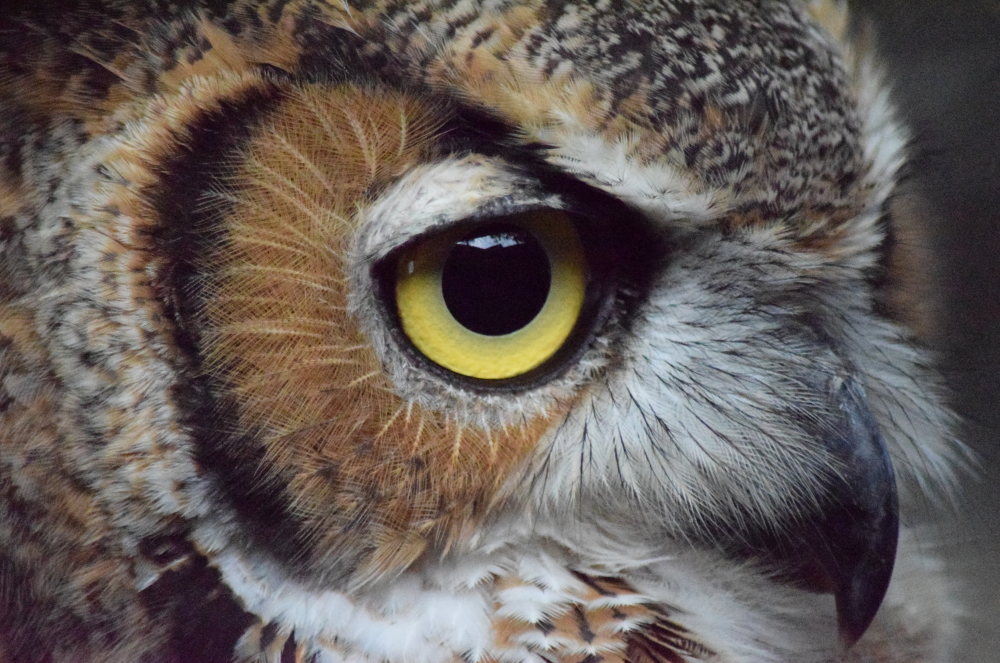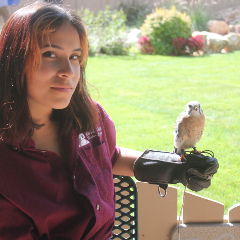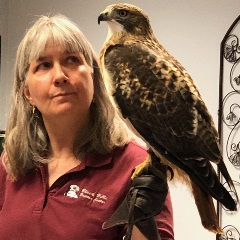Nothing speaks more to the majesty of the American West than a ferruginous hawk scribing lazy circles in the afternoon thermals, the lightning-quick dive of a peregrine falcon after its prey, or golden eagles soaring where only eagles dare.
South Dakota is home to a large and heterogeneous population of these amazing birds, particularly during the winter months. In fact, the 175-mile stretch of prairie grasslands along Highway 34 between Sturgis and Pierre has been designated by the state’s Department of Tourism as “Raptor Alley” due to the high density of the birds along this route.
The great raptors still reign supreme in the wild places of our region. But, like most creatures large and small, they have paid a steep price where their range overlaps with humans.
These birds of prey face many threats. They are hit by vehicles. They get ensnarled in barbed wire fences or fishing lines, or they collide with windows. They are the unintentional victims of rodenticides and the deliberate victims of poaching. And of course they suffer from loss or alteration of their habitats. Raptor centers around the country make every effort to rescue, rehabilitate and release our high-flying friends when they are injured.
Unfortunately, such a facility was not available in the Black Hills region of South Dakota until fairly recently. Previously, injured birds discovered by humans would be left to die or had to be euthanized.
Then, 12 years ago, two current members of the Rapid City Chapter of the Izaak Walton League of America took on the challenge of saving these wounded apex predators.
Black Hills Raptor Center
The Black Hills Raptor Center (BHRC) was organized with three goals in mind: provide triage, treatment, and rehabilitation for injured raptors; educate the public about these amazing creatures; and contribute to the body of science regarding raptors.
Birds of prey face many threats. They are hit by vehicles. They get ensnarled in barbed wire. And they suffer from loss or alteration of their habitats.
Co-founders Maggie Engler and John Halverson started the education program with four non-releasable raptors housed in mews (small buildings or bird apartments) in Engler’s back yard. It’s important to note that only raptors whose injuries preclude them from being released back to the wild are allowed to be maintained for educational purposes, according to U.S. Fish and Wildlife Service regulations. The Black Hills Raptor Center has permission, provided on a bird-by- bird basis, to use its raptors in its educational programs.
For years, community outreach was the most outward manifestation of the raptor work by Engler, Halverson and a small army of enthusiastic volunteers. The outreach has taken the form of bringing their “education birds” to all manner of school programs, outdoor and sports expositions, community and church groups, nursing homes, environmental gatherings and events at local, state and national parks.
Participating in more than 100 presentations most years, they have reached tens of thousands of people with their “raptor diplomacy.” They have introduced these wild creatures to kids and adults alike in a way that can influence and inspire for a lifetime. And that is their overarching mission, just as it is for the Izaak Walton League – to ensure that people stay connected to nature.
Elise, a red-tailed hawk, has been a BHRC resident since the organization’s inception in 2010. A peregrine falcon named Izaak Walton is the most recent arrival. They are currently joined in the mews by Freya, another red-tailed hawk; Phoenix, a ferruginous hawk; Aldo, a great horned owl; Hendrix and Joplin, both American kestrels; Gaia, a broad-winged hawk; and two Eastern screech owls, Big Bad Wolf and Little Red Riding Hoot.
But Engler and Halverson have major plans to greatly increase the number of residents in the BHRC mews, and a massive building program is underway to make their vision a reality.
 This great horned owl, Aldo, lives at the raptor center. Owls' fluffy build ensures that their flight is virtually silent, which improves hunting success.
This great horned owl, Aldo, lives at the raptor center. Owls' fluffy build ensures that their flight is virtually silent, which improves hunting success.
Expanding the Center to Help More Birds
More times than they can count, BHRC volunteers have rushed an injured raptor on a several-hours’ drive to the nearest facility that could treat their wounds, in central or eastern South Dakota. Often, these beautiful creatures did not survive that desperate journey.
 High school volunteer Zora Lone Eagle spends time with Hendrix, an American kestrel, the smallest of North American falcons.All of us involved in the effort hope that will soon change. An expanded Black Hills Raptor Center is making substantial progress toward changing the destiny of the region’s raptors on a five-acre nature preserve just east of Rapid City, South Dakota.
High school volunteer Zora Lone Eagle spends time with Hendrix, an American kestrel, the smallest of North American falcons.All of us involved in the effort hope that will soon change. An expanded Black Hills Raptor Center is making substantial progress toward changing the destiny of the region’s raptors on a five-acre nature preserve just east of Rapid City, South Dakota.
The BHRC must meet extremely specific and rigid requirements regarding facility design and outfitting to obtain the U. S. Fish and Wildlife Service permits that would allow the center to triage and treat wild raptors with the goal of releasing them back to the wild.
Over the previous decade, BHRC has acquired its five-acre parcel, and in the past few years, two of the six buildings designed for the planned complex at the preserve have been erected; a third is being planned for groundbreaking in the spring of 2023.
The Rapid City Chapter of the Izaak Walton League recently provided a donation of $25,000 to lay the foundation for this third building, the Rehabilitation and Research Hub, which will be the “nerve center” of the BHRC campus.
It is the biggest of the planned structures and will house offices, meeting rooms and, most importantly, a complete veterinary clinic. The clinic will include examination rooms, an ICU, labs, a digital X-ray room and a surgical suite. The completed facility will meet the primary requirements for the U.S. Fish and Wildlife Service permitting process so that BHRC can begin treating and rehabilitating raptors on site rather than, for example, rushing injured bald eagles across the state to a permitted facility for treatment, as it did on seven separate occasions in one recent 12-month period.
The Rapid City Chapter had engaged with this important work early on with another $10,000 grant during the land-acquisition phase of the project. We will continue to support completion of the BHRC campus and its mission as the final structures are finished – a much bigger mews building, a small education center and a free-flight aviary.
THE VITAL ROLE OF RAPTORS
Raptors include eagles, hawks, falcons and owls. In Latin, “raptor” means “to seize or grasp.” As birds of prey, raptors have powerful talons, or claws, used for hunting or defense. Their ability to see and hear exceeds humans many times over. Their diet ranges from small mammals and reptiles to insects and other birds.
If the beauty of a raptor in flight is not reason enough to love these birds, consider their roles in ecosystems as apex predators. They are one of our farmers’ best friends because of their voracious appetite for mice. A single pair of mice and several generations of their offspring can produce several thousand more mice in a year. Each eats four or five pounds of grain crops during that year and contaminates more with its waste.
We probably don’t associate raptors with flood control. But the Cornell Ornithology Lab reports that barn owls and other raptors in Southern California’s Ventura County protect dozens of flood-control dams and levees by eating ground squirrels and gophers. The Lab says, “a single gopher can excavate a ton of soil a year, and ground squirrels can burrow more than 30 feet.” These networks of tunnels and excavated soil can undermine the strength of earth levees.
The lifespan of raptors in the wild is hard to predict. The Cornell Lab says they may live five or six years, but most do not live beyond their first winter. “This is usually due to predation or starvation. If a bird makes it past their first winter, then locating food becomes their biggest concern."
Regional Reach for the Expanded Center
 Black Hills Raptor Center co-founder and Executive Director Maggie Engler introduces Freya during a program in South Dakota.When the BHRC campus is complete, it will provide raptor rescue, treatment and rehabilitation services to a region that includes South Dakota, North Dakota, eastern Wyoming and western Nebraska. It will also provide the resources to train additional volunteers for community outreach.
Black Hills Raptor Center co-founder and Executive Director Maggie Engler introduces Freya during a program in South Dakota.When the BHRC campus is complete, it will provide raptor rescue, treatment and rehabilitation services to a region that includes South Dakota, North Dakota, eastern Wyoming and western Nebraska. It will also provide the resources to train additional volunteers for community outreach.
Like all the environmentally oriented undertakings we at the Izaak Walton League pursue, the work at the BHRC is open-ended and never done. As a matter of fact, the pace of activity at the BHRC will steadily increase as the permitting process is completed, as more avian guests start to arrive on campus and as staff and volunteer numbers expand. The Rapid City Chapter stands ready to continue its partnership with the BHRC in this critical work.
Everyone involved in this endeavor at the BHRC anticipates the day when the first bird fully rehabilitated at the Black Hills Raptor Center – perhaps a bald eagle – is released back to the wild: one of nature’s most magnificent creatures given a second chance to take its rightful place in the great web of life.
Top photo: A red-tailed hawk, Freya, trains during an education program at the Center. Credit: Pine & Willow Photography.